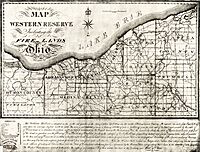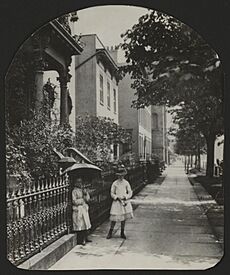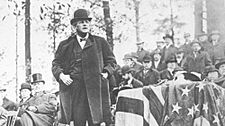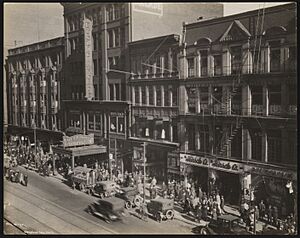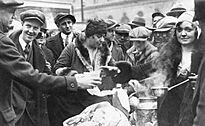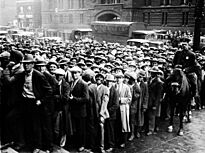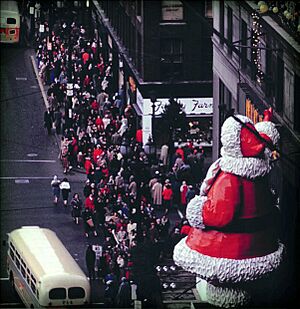History of Cleveland facts for kids
The city of Cleveland, Ohio, was started by General Moses Cleaveland on July 22, 1796. He was part of the Connecticut Land Company. Its great location on the southern shore of Lake Erie and at the mouth of the Cuyahoga River helped it become a big trading center. This happened in northern Ohio in the early 1800s. Cleveland was an important city during the American Civil War. It grew into a large industrial city. Many people came here for jobs and new chances. These included European and Middle Eastern immigrants. Also, African American migrants moved here.
For much of the 1900s, Cleveland was one of America's biggest cities. But after World War II, it faced challenges. Factories closed, and many people moved to the suburbs. Since the 1980s, the city has been slowly getting better. By the early 2000s, it became a major center for healthcare and the arts.
Contents
Early History of Cleveland
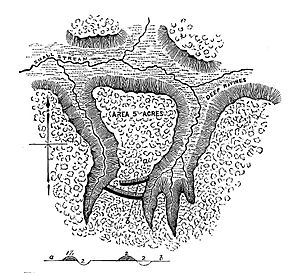
Long, long ago, about 15,000 years ago, the area around Lake Erie was very cold. It was like a tundra. Over thousands of years, the land became warmer and drier. Animals like caribou, moose, deer, wolves, bears, and cougars lived here.
The first people, called Paleo-Indians, arrived around 10,500 BC. They had an early settlement in Medina County. Tools made from flint from Indiana have been found.
Around 7500 BC, the weather became stable and warm, much like today. More people lived here. These early people, from the Early Archaic Culture, lived in large families. They settled along rivers and lake shores. In warm seasons, they gathered for hunting and collecting food. Their tools got better, and flint was still very important.
More people lived here during the Middle Archaic period (4500-2000 BC). They used polished stone tools and ornaments. Many different types of stone tools were found. These were found at sites along the Cuyahoga, Rocky River, and other creeks.
The Late Archaic period (2000 to 500 BC) was even warmer. People started to have specific areas where they lived. They also began to grow squash, which became very important later. There was trade over long distances. People traded raw materials and special items for ceremonies and burials. The largest known burial ground is at the Rocky River.
During the Early Woodland (500 BC – AD 100) and Middle Woodland (AD 100 – 700) times, people had more ceremonies and rituals. They made pottery with fancy decorations. Squash became more important, and maize (corn) was used for rituals. The first Mounds (earth structures) were built. Ohio is famous for these mounds. Some mounds were found in the Cleveland area, showing trade with distant places.
After AD 400, maize became the main crop. People stopped building large mounds. More groups of people lived in the area. They had winter villages along the Cuyahoga, Rocky, and Lower Chagrin Rivers. Their houses were small and round. In spring, people camped along the lakeshore. They collected plants and fished.
Between AD 1000 and 1200, summer villages had oval houses. Burial ceremonies became more personal. They included ornaments or tools.
From 1200 to 1600, new styles of pottery and houses appeared. New crops like common beans were grown. This shows influence from the Mississippian culture to the south. Agriculture became very important between 1300 and 1500. Villages grew larger and houses became rectangular. Some villages were like fortresses. Burial grounds were placed outside the villages. These villages were used all year.
The final Whittlesey Tradition, starting around 1500, shows long-houses and fortified villages. It was likely a time of conflict. Villages were very strong. The population decreased until about 1640. This was probably due to a "little ice-age" and ongoing conflicts. The Cleveland region was likely empty between 1640 and 1740.
Cleveland's Beginnings (1796-1860)
Founding the City (1796–1820)
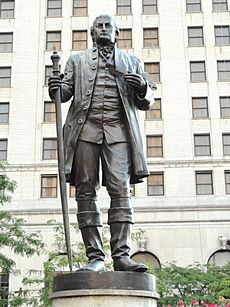
General Moses Cleaveland was chosen to map land for the Connecticut Land Company. On July 22, 1796, he and his team arrived at the Cuyahoga River. Cleaveland saw this land, which belonged to Native Americans, as a perfect spot for a new city. He planned a large Public Square, like those in New England. His team named the town "Cleaveland" after him. Moses Cleaveland went back to Connecticut and never returned to Ohio. The town's name was often shortened to "Cleveland."
Job Phelps Stiles and his wife Talitha Cumi Elderkin were among the first settlers. They stayed through the first winter of 1796–1797. Talitha Cumi gave birth to Charles Phelps Stiles, the first white child born in the area. The first permanent European settler was Lorenzo Carter. He built a log cabin by the Cuyahoga River.
Even though the area had swamps and harsh winters, Cleveland's location was very good. It was chosen as the main town for Cuyahoga County in 1809. Cleveland also became an important supply stop for the U.S. during the War of 1812. The village of Cleaveland officially became a town on December 23, 1814. Alfred Kelley was elected its first president in 1815.
From Village to City (1820–1860)
Cleveland grew quickly after the Ohio and Erie Canal was finished in 1832. This canal made the village a key link between the Ohio River and the Great Lakes. Later, railroad lines were added. In 1822, a lawyer named John W. Willey came to Cleveland. He became popular in local politics. He helped write the city's rules and laws. Willey oversaw Cleveland becoming an official city in 1836. He was elected the first mayor.
Willey and others bought land in The Flats to build a new area. He also bought land across from Columbus Street in Ohio City. He built a bridge connecting the two areas. This bridge helped Cleveland's businesses.
These actions made citizens of Ohio City angry. A big rivalry started between the two towns. In October 1836, Ohio City citizens tried to stop the use of Cleveland's new bridge. They dug ditches to block it. Some even used weapons. Willey and armed Cleveland citizens met them. A fight happened on the bridge, and two men were hurt. The sheriff stopped the conflict. The two cities eventually made peace. Ohio City joined Cleveland in 1854.
The Columbus bridge was very important for Cleveland. It allowed goods to come into the city from nearby farms. This helped Cleveland's trade grow. The Ohio and Erie Canal also made Cleveland a major Great Lakes port. Later, the town grew as a stop for iron ore from Minnesota and coal from the south. During this time, many immigrants came to Cleveland. They were mostly from Ireland and the German states.
Cleveland During the Civil War (1861–1865)
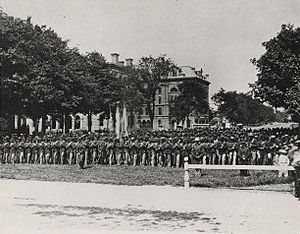
Cleveland had strong feelings against slavery. Many people here were abolitionists. The city was a major stop on the Underground Railroad. This was a secret network that helped escaped African American slaves reach Canada. Cleveland was known for its support for African Americans.
In the 1860 election, Abraham Lincoln won most of the votes in Cleveland. In February 1861, Lincoln visited Cleveland on his way to become president. He received a huge welcome. When the American Civil War began in April 1861, Clevelanders supported the Union.
The Civil War brought a big economic boost to Cleveland. The city was becoming a major industrial center. Local factories made railroad iron, gun parts, and gunpowder. By 1865, Cleveland's banks held a lot of money. When the war ended, the city welcomed its soldiers home with a special ceremony. In 1894, the Soldiers' and Sailors' Monument was opened to honor Union soldiers. After Lincoln was killed in 1865, his casket passed through Cleveland. Thousands of people watched the procession.
Growth and Change (1865-1919)
Industrial Boom and New People (1865–1899)
The Civil War helped Cleveland become a top American manufacturing city. It grew very fast. Many large steel companies were based here. In 1883, Samuel Mather started Pickands Mather and Company. This company focused on shipping and iron mining. Cleveland also became a major oil refining center. In 1870, Standard Oil began in Cleveland. Its founders included John D. Rockefeller and Henry M. Flagler. Many grand houses were built on streets like Euclid Avenue, known as Millionaire's Row.
As the economy grew, more immigrants came to Cleveland. By 1870, the city's population had more than doubled since 1860. A large part of the population was foreign-born. Besides the Irish and Germans, many new immigrants arrived. They came from Southern and Eastern Europe. They were looking for jobs and a better future in America. By 1890, Cleveland was the 10th largest city in the nation. The Cleveland Arcade opened that year.
With city growth came a need for better services. These included police, fire protection, housing, schools, and roads. There were also many strikes as workers demanded better conditions. Many strikes in Cleveland from 1881–86 helped improve working life. The Cleveland Streetcar Strike of 1899 was a notable labor conflict.
Politically, the Republicans became very strong in Cleveland after the war. Mark Hanna, an industrialist, became a powerful political leader. He was challenged by Robert E. McKisson, who became mayor in 1895. McKisson started building new water and sewer systems. He also wanted the city to own all utilities. After two terms, he lost to a group of Democrats and Hanna Republicans.
The Progressive Era (1900–1919)
In the early 1900s, Cleveland was a rising city. It was called the "Sixth City" because it was the sixth largest U.S. city. Businesses included car companies like Peerless and Winton. Winton made the first car driven across the U.S. Other companies made steam-powered and electric cars. The city's population kept growing. Besides new immigrants, African American migrants came from the rural South. They were part of the Great Migration. They sought jobs and freedom from racial discrimination.
Cleveland's government needed big changes. After some problems, progressive Democrat Tom L. Johnson became mayor in 1901. Johnson worked for "home rule" (local control) and fair taxes. He started the Group Plan of 1903. This plan created The Mall, a civic center. Johnson also worked to make city hall more professional.
Johnson's friend, Newton Baker, became mayor in 1911. Baker helped write a new Ohio law. This law gave cities the right to govern themselves. He played a big part in Cleveland's first home rule charter in 1913. Later, he became the United States Secretary of War for President Woodrow Wilson.
The Progressive era had a lasting effect on Cleveland. Wealthy people supported new cultural places. The Cleveland Museum of Art (CMA) opened in 1916. The Cleveland Orchestra started in 1918. The CMA offered free admission to everyone.
Harry L. Davis became mayor after Baker. Davis created a committee to help with the American effort in World War I. After the war, there were tensions. The local Socialists and the Industrial Workers of the World (IWW) demanded better working conditions. Many workers were immigrants. These tensions led to the Cleveland May Day Riots of 1919. Demonstrators clashed with anti-socialists. Mayor Davis's home was also bombed. Davis then called for the removal of "Bolsheviks" from America. He resigned in May 1920 to run for governor. He would serve as mayor again in 1933.
Modern Cleveland (1920-Present)
The Roaring Twenties (1920–1929)
The Roaring Twenties was a good time for Cleveland. In 1920, the Cleveland Indians won their first World Series. Cleveland had grown into a busy city of almost 800,000 people. About 30% of them were born in other countries. This made it the fifth largest city in the nation. In 1923, Albert Tinnerman invented the speed nut in Cleveland. This invention helped assembly lines in car and airline factories.
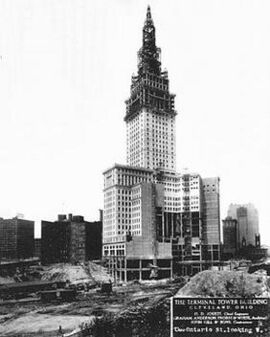
Jazz music came to Cleveland from New Orleans. New jazz talent also came from Cleveland Central High School. The era of the flapper brought a golden age for shopping in Downtown Cleveland. Big department stores like Higbee's and May Company made it a major shopping area. In 1929, the city hosted the first of many National Air Races. Amelia Earhart flew to the city for the Women's Air Derby.
In politics, the city tried a new system in 1924. William R. Hopkins became the first city manager. He oversaw the development of parks and the Cleveland Municipal Airport. In 1923, the Federal Reserve Bank of Cleveland building opened. In 1925, the main Cleveland Public Library building opened. Linda Eastman was the first woman to lead a major library system in the world. In 1926, the Van Sweringen brothers began building the Terminal Tower skyscraper. By the time it was finished in 1930, Cleveland had over 900,000 people. The Terminal Tower was the tallest building outside of New York until 1967.
The Great Depression (1929–1939)
On October 24, 1929, the stock market crashed. This started the Great Depression. Cleveland was hit very hard. By 1933, about half of Cleveland's factory workers had lost their jobs.
People wanted to end Prohibition (the ban on alcohol). Groups like the Crusaders grew in Cleveland. They wanted to stop organized crime and end Prohibition. Cleveland became their national headquarters. When Franklin D. Roosevelt became president, Prohibition was close to ending. It was finally repealed in Cleveland on December 23, 1933.
The city changed its government system back to a mayor–council system. Harold H. Burton became the new mayor. Burton, a lawyer, wanted to help Cleveland recover. He appointed Eliot Ness as his Safety Director. Ness had helped put Al Capone in jail. Ness worked to improve the city's police department. He fired bad officers and hired new ones. Crime in the city dropped a lot during his time. He also improved traffic safety.
Cleveland was a center for union activity. There were big labor struggles. Workers went on strike against Fisher Body in 1936 and Republic Steel in 1937. President Roosevelt's New Deal projects also helped the city. To celebrate 100 years since Cleveland became a city, the Great Lakes Exposition opened in June 1936. It drew millions of visitors.
World War II and After (1940–1962)
On December 7, 1941, Japan attacked Pearl Harbor. This brought America into World War II. Cleveland was a major part of the "Arsenal of Democracy". Under Mayor Frank Lausche, Cleveland was the fifth largest manufacturing center. It contributed greatly to the U.S. war effort. Lausche also started the Cleveland Transit System.
After the war, Cleveland had an economic boom. Businesses called it the "best location in the nation." In 1949, Cleveland was named an All-America City. In 1950, its population reached over 914,000. In sports, the Indians won the 1948 World Series. The hockey team, the Barons, became champions. The Browns were very strong in professional football in the 1950s. Cleveland was called the "City of Champions." The 1950s also saw the rise of "rock and roll" music. Local disc jockey Alan Freed gave it that name.
After Lausche became Governor, Thomas A. Burke became mayor in 1945. Burke was re-elected in 1947. His biggest achievement was a large improvement program. This included the Cleveland Burke Lakefront Airport. He also managed race relations well. In 1954, Anthony J. Celebrezze became Cleveland's first Italian American mayor. Celebrezze finished Cleveland's Rapid Transit and expanded the freeway system. He also started the Erieview Urban Renewal Plan. Celebrezze was very popular. He served five terms before joining President John F. Kennedy's cabinet.
Challenges and Changes (1962–1979)
Ralph S. Locher became mayor in 1962. Cleveland's economy began to slow down. People moved to the suburbs. Factories closed, and many jobs were lost. Housing discrimination led to racial tension. In Cleveland, this tension led to the Hough Riots in July 1966. Locher became less popular. He lost the 1967 mayoral election to Carl B. Stokes. Stokes became the first African American mayor of a major U.S. city. This attracted national attention.
As mayor, Stokes started reforms to help the city's economy. He got funds for urban renewal. He also convinced the City Council to increase the city's income tax. Stokes led efforts to clean up Cleveland's Cuyahoga River. A river fire in June 1969 brought national attention to industrial pollution. This fire was the last in the city's history. It helped start the American environmental movement. The river has been cleaned up a lot since then.
In 1968, Stokes launched Cleveland: Now!. This program aimed to improve poorer neighborhoods. It was successful at first. However, after the 1968 Glenville Shootout, it was found that a group involved had received money from Cleveland: Now!. This put the mayor in a tough spot. Stokes won re-election in 1969. But conflicts with City Council led him not to seek a third term in 1971.
Ralph J. Perk became mayor next. He was the first Republican mayor since the 1940s. Perk had good connections with President Richard Nixon. This helped Cleveland get federal money for neighborhoods and to fight crime. Perk suggested combining Cleveland's public transit with nearby suburbs. This created the Greater Cleveland Regional Transit Authority. He also expanded Cleveland's international ties. However, Perk was also known for some funny mistakes. The city continued to lose people. This was due to factories closing and school busing. By 1980, Cleveland was no longer one of the top 10 largest U.S. cities.
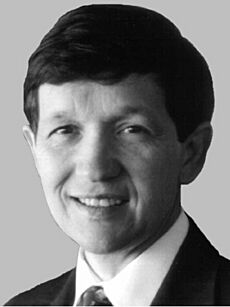
In 1977, Dennis J. Kucinich became mayor. He was 31, the youngest mayor of a major U.S. city. His time as mayor started with the Great Blizzard of 1978. Kucinich had conflicts with his police chief and City Council. This led to a recall election. Kucinich almost lost his job but won by a very small number of votes.
Kucinich had promised not to sell the city's electric company, Muny Light. The previous mayor had started the sale. Kucinich stopped it. A private electric company then demanded money from Muny Light. Cleveland banks said they would only lend money to the city if Kucinich sold Muny Light. He refused. On December 15, 1978, Cleveland became the first major American city since the Great Depression to default on its loans. Voters were tired of the problems. In the 1979 election, Kucinich lost to Republican George V. Voinovich.
Recent History (1980-Present)
Recovery and Growth (1980–2005)
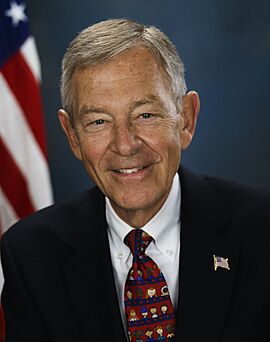
In the early 1980s, Cleveland faced a tough economic time. Many steel factories closed. Unemployment was high. But under Mayor Voinovich, the city began to recover. Voinovich oversaw the building of new skyscrapers like the Key Tower. He also developed the Gateway Sports and Entertainment Complex. This includes Progressive Field and Rocket Mortgage FieldHouse. The North Coast Harbor was also developed. It includes the Rock and Roll Hall of Fame, FirstEnergy Stadium, and the Great Lakes Science Center. By 1987, Cleveland was out of debt. It was named an All-America City multiple times. After being mayor, Voinovich became the Governor of Ohio.
Michael R. White became mayor next. He continued the development plans downtown. These included areas near the Gateway complex and the Rock and Roll Hall of Fame. After three terms, he decided not to run again in 2001.
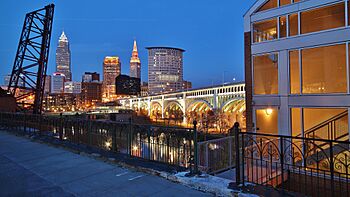
In 2002, Jane L. Campbell became the city's first female mayor. During her time, the city's economic recovery seemed to slow down. The steel and auto industries continued to decline. The city's public schools faced challenges. Still, some city neighborhoods received investments for improvements. These included Downtown, Tremont, and Ohio City. In the 2005 mayoral election, Campbell lost to City Council president, Frank G. Jackson. Jackson became mayor on January 1, 2006.
Continued Evolution (2006–Present)
When Jackson became mayor, Cleveland still faced challenges. These included keeping people living in the city and the impact of the Great Recession. However, by the early 2000s, Cleveland had a more varied economy. It became known as a national center for healthcare and the arts. It also became a leader in environmental protection, thanks to the cleanup of the Cuyahoga River. Downtown and several neighborhoods have grown in population since 2010. In 2018, Cleveland's population stopped declining. The city also saw big wins in sports. The Cleveland Cavaliers won the 2016 NBA Finals. This was the first major championship for a Cleveland team since 1964.
Challenges still remain for the city. These include improving neighborhoods, city schools, and fighting poverty. In June 2020, Cleveland City Council declared that racism is a public health emergency. A new mayor, Justin Bibb, was elected in 2021.
Cleveland Inventions and Firsts
- 1863 – Free home delivery of mail.
- 1879 – Electric lighting of public streets.
- 1880 – Standardized formula paints by Sherwin-Williams Co..
- 1890 – Indoor shopping center (The Arcade).
- 1896 – X-ray machine and whole-body scanner.
- 1898 – First automobile sale in the U.S. by Alexander Winton.
- 1899 – Wound-rubber core golf ball.
- 1900 – First automobile club.
- 1901 – Automobile steering wheel by Alexander Winton.
- 1905 – First blood transfusion by Dr. George W. Crile, Sr..
- 1910 – Automobile shock absorbers.
- 1914 – Electric traffic signal at Euclid Ave. & East 105th St.
- 1915 – Submachine gun.
- 1916 – Gas mask successfully shown by Garrett A. Morgan.
- 1920 – Unassisted triple play in a World Series Baseball Game.
- 1921 – Automobile windshield wiper.
- 1927 – Municipal airport (Cleveland Hopkins International) and air traffic control tower.
- 1928 – Frosted light bulbs.
- 1929 – Airplane automatic pilot (tested).
- 1936 – First health museum.
- 1951 – Rock and Roll Music (public recognition and coinage of the term) by Alan Freed.
- 1952 – Successful Siamese twin separation.
- 1967 – Elected the first African American mayor of a major U.S. city - Carl B. Stokes.
- 1967 – Coronary artery bypass by Dr. René Favaloro at Cleveland Clinic.
- 1968 – Rapid transit rail service from airport to downtown.
|



